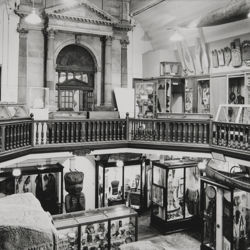The Museum was founded in the 1880s, when the global empires of European nations were expanding rapidly, there was growing debate around humanity's history and cultural diversity, and increasing interest in material culture, technology and the arts of peoples worldwide. Some scholars in Britain and elsewhere theorised 'social evolution' and promoted racist categories. Others believed that museums could promote understanding of the cultures and achievements of people worldwide.
Origins
Like many museums, MAA grew out of a local scientific society. The Cambridge Antiquarian Society had assembled archaeology collections from 1839 on, and lobbied the University to establish a museum. Their efforts were supported Sir Arthur Hamilton Gordon. A former student of Trinity College, he was Governor of Fiji in the 1870s. He had been encouraged to collect artefacts by a young Anglo-Austrian scientific traveller, Baron Anatole von Hügel. Donations from Gordon, the Cambridge Antiquarian Society and material from Alfred Maudslay, a pioneer of central American archaeology, constituted the Museum's first collections.
Von Hügel was appointed Curator, and was ambitious in fundraising for the purpose-built building, which was opened in 1913, and in expanding the collections. The 1898 Cambridge Expedition to the Torres Strait, led by Alfred Haddon, was the most important of early field research projects, and brought thousands of carefully-documented artefacts, photographs, sound recordings and drawings by Indigenous people. Trinity College placed exceptionally significant archaeological and anthropological collections 'on deposit' in the Museum (meaning that the College retained ownership of the objects). These included 102 artefacts from the first voyage of Captain James Cook, the earliest world cultures collection to be made in the field and systematically documented, and Roman inscribed stones, mostly from northern Britain, which were collected by the Stuart antiquarian Sir Robert Cotton.
The twentieth century
Through the twentieth century, Cambridge archaeologists, anthropologists and other researchers brought collections made in the field back to the Museum. They included leading scholars in their disciplines, such as Dorothy Garrod, Gregory Bateson, Kathleen Kenyon, Meyer Fortes, Jack Goody and Marilyn Strathern. From the 1990s on, MAA became recognised increasingly for a commitment to collaboration with local and Indigenous communities, regularly hosting researchers, students, curators and artists from the Pacific, Africa, the Americas and Asia. The Museum has sustained close engagement with archaeological research locally; a major redevelopment over 2010-12 created a Cambridge gallery on the Museum's ground floor and a public entrance from Downing Street.
In modern times...
Over the last 10-15 years, MAA has presented major temporary exhibitions on themes including the body, the archaeology of childhood, and Indigenous modernist art, as well as on Indigenous India, Fiji and Mongolia. Alongside international partnerships, MAA is active as a public museum, part of the University of Cambridge Museums consortium, closely engaged with schools and communities in Cambridge and our region.










